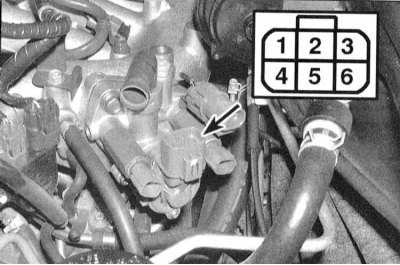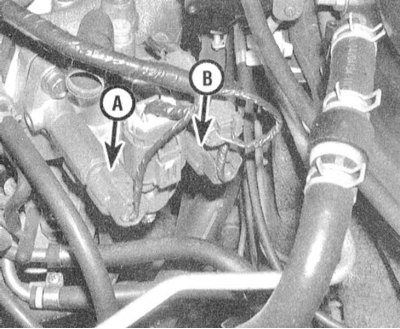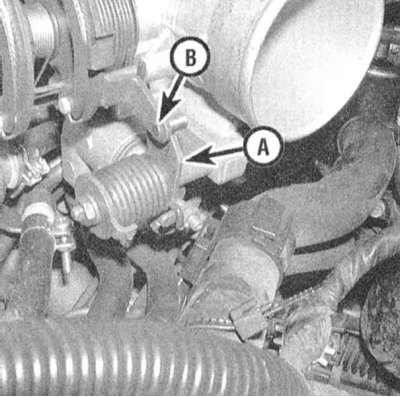Attention! When working in the engine compartment, be careful to keep hands, hair, and clothing away from moving components such as drive belts, fan blades, etc.
Idle speed control valve (IAC)
When the engine is idling, the air/fuel mixture is controlled by the idle speed control valve (IAC). The IAC valve is activated by PCM command, depending on the current engine load (turning on the air conditioner, using the power steering, unit temperature, etc.). The valve regulates the amount of air flow supplied to the intake manifold bypassing the throttle. The PCM receives initial data from the VSS, ECT sensors, PSP sensor-switches and the operation of the A/C compressor clutch. Depending on the current load on the engine, the module adjusts its idle speed accordingly. To avoid idle stability when starting the engine, the IAC valve opens when the engine is cranking and remains open for some time immediately after starting, providing additional air to the intake manifold.
Examination
Note. Performing the procedure described below may lead to the entry into the OBD memory of a malfunction, which will be highlighted by a control lamp "Check engine". Upon completion of the check and the corresponding remedial repair, do not forget to clear the system memory (see Section On-Board Diagnostic System (OBD) - the principle of operation and fault codes).
1. Check the correct supply voltage to the valve. Disconnect wiring from valve. Turn on the ignition. Ground the negative probe of the voltmeter to ground and alternately probe with the positive probe each of the two terminals of the red wires of the connector wiring harness - the meter should register battery voltage, otherwise check the condition of the wiring in the sections of the circuit between the ECCS relay and the battery (don't forget the fuses) and ECCS relay and IAC valve (see wiring diagrams at the end of the Chapter Onboard electrical equipment).

2. To check the IAC valve, measure the resistance between the corresponding terminals of its connector. At 20°C, the resistance should be approximately 30 ohms. If no abnormalities can be identified, the car should be driven to a service station for a detailed diagnosis of the PCM.
Replacement
1. Disconnect the electrical wiring from the IAC valve.
2. On 1993 and 1994 models. issue Disconnect the hose from the valve cover. Turn out four fixing bolts and release the valve from the inlet pipeline.
3. On models since 1995, no. unscrew the two fixing screws and remove the valve from the casing.
4. Wipe the outer surface of the valve and the walls of its seat with a clean rag.
Attention! Never flush the valve with any solvent!
5. Fit a new O-ring into the housing and lubricate it with light machine oil.
6. Install the valve in its proper place and securely tighten the fasteners.
7. Further installation is carried out in the reverse order to the dismantling of the relevant components.
Fast idle control solenoid valve
On models since 1995, no. There are two fast idle control solenoid valves. The valves ensure the stability of the engine speed, regardless of changes in the current load. One valve is activated when the power steering is activated, the second when the air conditioner is turned on. Activation of the valves leads to an increase in the intensity of the air flow sucked into the intake pipe. System failure is not tracked by OBD.
Examination

A - Solenoid valve for compensating for increased load associated with the operation of the power steering
B - Solenoid valve for compensating for increased load associated with the operation of A/C
1. Start the engine and turn the steering wheel all the way in any direction, then return it to the center position - the engine speed should not change, the inclusion of K / V should also not lead to a change in speed, otherwise check the condition of the corresponding solenoid valve.
2. Disconnect the electrical wiring from the solenoid valve. Connect the positive probe of the voltmeter to the red-yellow or yellow-blue wire terminal of the wiring harness on the connector. Ground negative probe. With the ignition on and K / V, battery voltage must be present at the valve connector B, otherwise, check the condition of the wiring in the section of the circuit between the valve and the fuse mounting block (do not forget to check the condition of the relevant fuses). If the A/C compressor clutch does not engage when the system is turned on, also check the condition of the relevant relay. Check the condition of the PSP switch (see Section Checking the condition and replacing the pressure sensor-switch in the power steering system (PSP)) and the quality of its grounding.
3. Turn off the ignition. using a pair of jumper wires, apply battery power to the terminals of the corresponding solenoid valve - a clearly audible click should be heard, otherwise the valve must be replaced. Remove valve (see below) and check the freedom of movement of its plunger. If the plunger is stuck or the retaining spring is broken, the valve must also be replaced.
Replacement
1. Disconnect the wiring harness from the fast idle control solenoid valve.
2. Using a wrench, release the valve from the IAC valve housing.
3. Replace the copper sealing washer, then screw the valve into place and tighten securely.
4. Further installation is carried out in the reverse order to the dismantling of the relevant components.
Fast idle cam
The fast idle cam is a thermocouple and is used on models from 1995 onwards. to increase idle speed when starting a cold engine. Until the engine has warmed up, the fuser plunger remains in its normal position and the fast idle cam acts on the throttle lever, slightly moving it away from the stop, which leads to an increase in engine idle speed. As the engine warms up, the plunger retracts and rotates the cam in this manner. That the lever returns to its base position.
Check and adjustment
Note. Performing the procedure described below may lead to the entry into the OBD memory of a malfunction, which will be highlighted by a control lamp "Check engine". After completing the check and the corresponding remedial repair, do not forget to clear the system memory (see Section On-Board Diagnostic System (OBD) - the principle of operation and fault codes).
1. Disconnect the wiring from the ECT sensor and connect an ohmmeter to the two terminals of the latter (see Section Checking the condition and replacing the engine coolant temperature sensor (EATING)).

2. Start the engine and observe the temperature sensor resistance change. When the sensor resistance reaches 1650 ÷ 2400 ohms, the long mark on the fast idle cam should align with the center of the actuating lever pin.
3. Do not turn off the engine - when the resistance of the ECT sensor drops to a level of 260 ÷ 390 Ohm, a short cam mark should be aligned with the central part of the finger, otherwise loosen the lock nut and turn the adjusting screw to achieve the desired result.
4. If the cam cannot be adjusted, replace the throttle body (see chapter Power and exhaust systems).